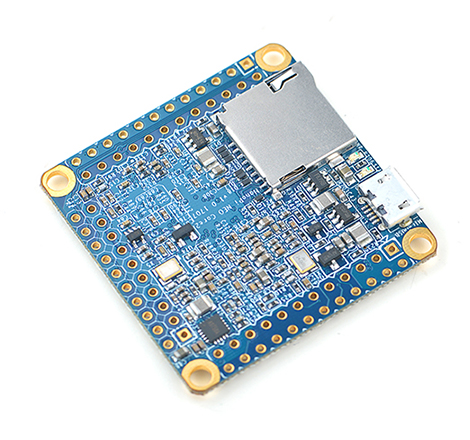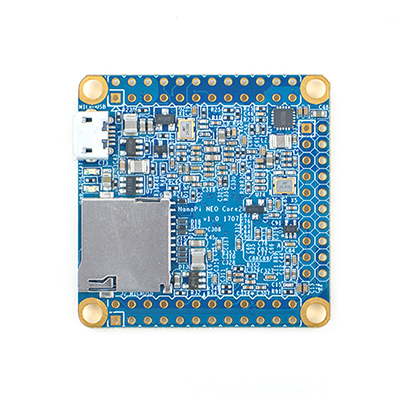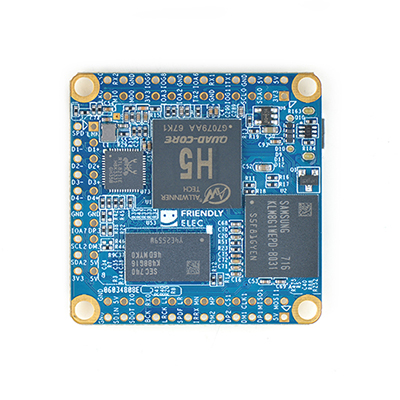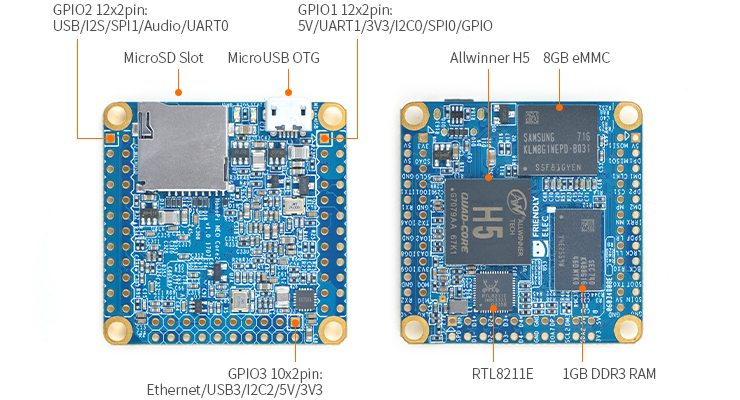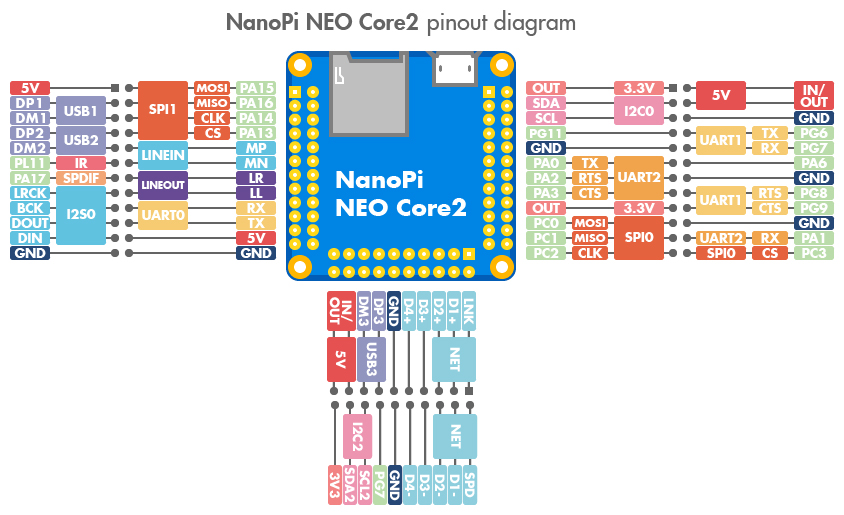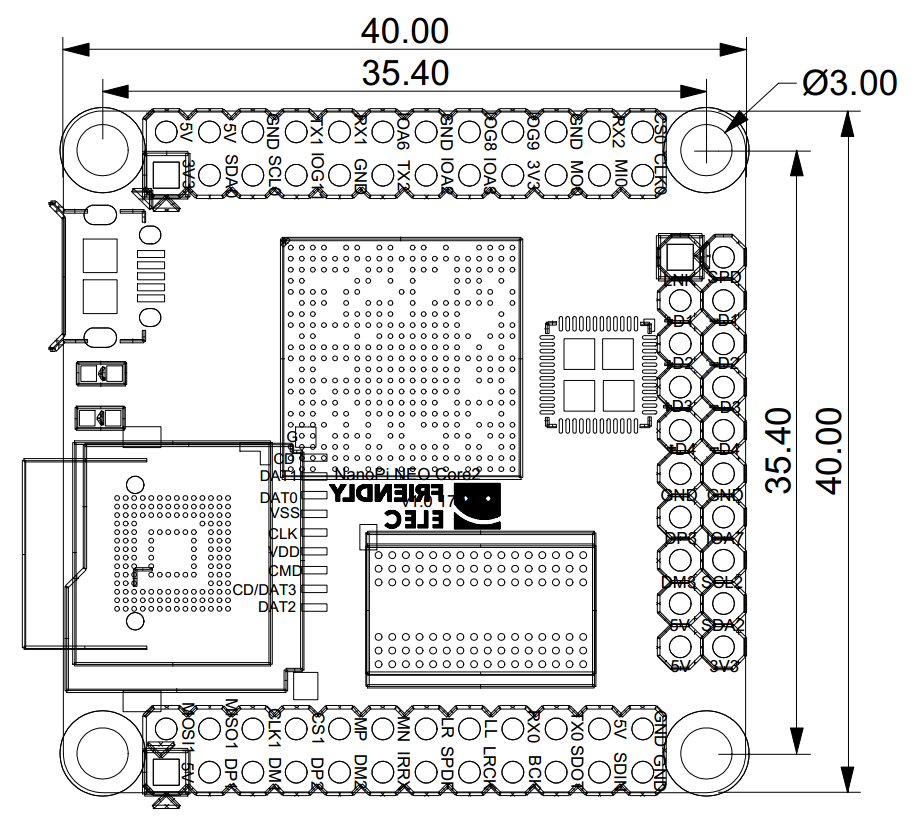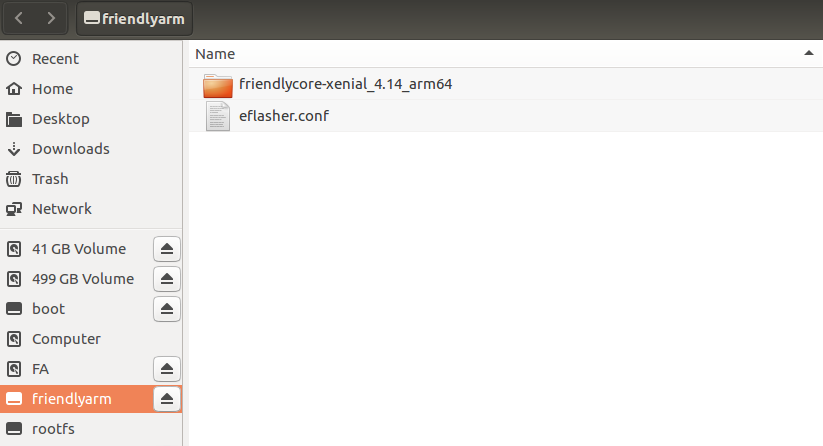NanoPi NEO Core2
Contents
- 1 Introduction
- 2 Hardware Spec
- 3 Diagram, Layout and Dimension
- 4 Software Features
- 5 Get Started
- 6 Mini Shield for NanoPi NEO Core/Core2
- 7 Work with FriendlyCore
- 7.1 Introduction
- 7.2 System Login
- 7.3 Configure System with npi-config
- 7.4 Develop Qt Application
- 7.5 Setup Program to AutoRun
- 7.6 Extend TF Card's Section
- 7.7 WiFi
- 7.8 Ethernet Connection
- 7.9 WiringPi and Python Wrapper
- 7.10 Custom welcome message
- 7.11 Modify timezone
- 7.12 Set Audio Device
- 7.13 Connect to USB Camera(FA-CAM202)
- 7.14 Check CPU's Working Temperature
- 7.15 Test Watchdog
- 7.16 Test Infrared Receiver
- 7.17 Read CHIP ID
- 7.18 Access GPIO Pins/Wirings with WiringNP
- 7.19 Run Qt Demo
- 7.20 How to install and use docker (for arm64 system)
- 7.21 Play & Record Audio
- 8 Make Your Own FriendlyCore
- 9 Connect External Modules to NEO Core2
- 9.1 Connect Python Programmable NanoHat OLED to NEO Core2
- 9.2 Connect Python Programmable NanoHat Motor to NEO Core2
- 9.3 Connect NanoHat PCM5102A to NEO Core2
- 9.4 Connect Arduino Compatible UNO Dock to NEO Core2
- 9.5 Connect NanoHat Proto to NEO Core2
- 9.6 Connect Matrix - 2'8 SPI Key TFT to NanoPi NEO Core2
- 10 3D Printing Files for Housing
- 11 Resources
- 12 Update Log
1 Introduction
- The NanoPi NEO Core2 as its name tells is an alternative NanoPi NEO2 that works like a CPU board with male pin-headers. It has the same form facotor as the NanoPi NEO2, same pin descriptions and works with all the OS images the NanoPi NEO2 supports. The connectors and ports on the NEO2 are populated to pin-headers on the NEO2 Core. In addition the NEO Core2 can have an optional onboard eMMC flash and ESD protection for connectors and ports. There features are highly preferred by industrial customers.
- The NEO2 Core uses a popular Allwinner H5 SoC and has onboard 1G DDR3 RAM. FriendlyElec offers models with three eMMC options: 8GB(default)/16GB/32GB. FriendlyElec migrated UbuntuCore with mainline kernel 4.14 for it. It works with other OS such as Armbian as well. Compared to the NanoPi NEO2 the NanoPi NEO Core2 runs more reliably with much less overheat. It is a good platform for IoT applications, mornitoring systems, smart control systems, cluster computing and AI applications.
- FriendlyElec develops a Mini Shield for NanoPi NEO Core/Core2 which has the same form factor as the RPi 3. When a NanoPi NEO Core2 is connected to this Mini Shield the whole assembled module can be well fit into a common RPi 3's case.
2 Hardware Spec
- CPU: Allwinner H5, Quad-core 64-bit high-performance Cortex A53
- DDR3 RAM: 512MB/1GB
- Storage: 8GB/16GB/32GB eMMC
- Connectivity: 10/100/1000M Ethernet utilizing RTL8211E-VB-CG
- USB Host x 3(included in 2.54mm pitch pin header)
- MicroSD Slot x 1
- LED: x 2, one for power status and the other for system status
- GPIO1: 2.54mm pitch 12 x 2 pin header containing UART, SPI, I2C, GPIO and etc
- GPIO2: 2.54mm pitch 24 pin header containing SPI, IR, I2S, USB, serial debug port, audio and etc
- GPIO3: 2.54mm pitch 20 pin header containing USB, Gbps Ethernet, I2C and etc
- PCB Size: 40 x 40mm
- MicroUSB: OTG and power input
- OS/Software: u-boot,Ubuntu Core
- Weight: xxg(Without Pin-headers)
3 Diagram, Layout and Dimension
3.1 Layout
- GPIO1 Pin Description
Pin# Name Linux gpio Pin# Name Linux gpio 1 SYS_3.3V 2 VDD_5V 3 I2C0_SDA / GPIOA12 12 4 VDD_5V 5 I2C0_SCL / GPIOA11 11 6 GND 7 GPIOG11 203 8 UART1_TX / GPIOG6 198 9 GND 10 UART1_RX / GPIOG7 199 11 UART2_TX / GPIOA0 0 12 GPIOA6 6 13 UART2_RTS / GPIOA2 2 14 GND 15 UART2_CTS / GPIOA3 3 16 UART1_RTS / GPIOG8 200 17 SYS_3.3V 18 UART1_CTS / GPIOG9 201 19 SPI0_MOSI / GPIOC0 64 20 GND 21 SPI0_MISO / GPIOC1 65 22 UART2_RX / GPIOA1 1 23 SPI0_CLK / GPIOC2 66 24 SPI0_CS / GPIOC3 67
- GPIO2 Pin Description
Pin# Name Description Pin# Name Description 1 VDD_5V 2 MOSI1 SPI1-MOSI 3 USB-DP1 USB1 DP Signal 4 MISO1 SPI1-MISO 5 USB-DM1 USB1 DM Signal 6 CLK1 SPI1-CLK 7 USB-DP2 USB2 DP Signal 8 CS1 SPI1-CS 9 USB-DM2 USB2 DM Signal 10 MP Microphone Positive Input 11 GPIOL11 / IR-RX GPIOL11 or IR Receive 12 MN Microphone Negative Input 13 SPDIF-OUT / GPIOA17 GPIOA17 or SPDIF-OUT 14 LR LINE-OUT Right Channel Output 15 PCM0_SYNC / I2S0_LRCK/I2C1_SCL I2S/PCM Sample Rate Clock/Sync 16 LL LINE-OUT Left Channel Output 17 PCM0_CLK / I2S0_BCK/I2C1_SDA I2S/PCM Sample Rate Clock 18 RXD UART_RXD0/GPIOA5/PWM0 19 PCM0_DOUT / I2S0_SDOUT I2S/PCM Serial Bata Output 20 TXD UART_TXD0/GPIOA4 21 PCM0_DIN / I2S0_SDIN I2S/PCM Serial Data Input 22 VDD_5V 23 GND 0V 24 GND 0V
- GPIO3 Pin Description
Pin# Name Description Pin# Name Description 1 LINK-LED Ethernet Link LED 2 SPEED-LED Ethernet Speed LED 3 TRD1+ Ethernet TRD1+ Signal 4 TRD1- Ethernet TRD1- Signal 5 TRD2+ Ethernet TRD2+ Signal 6 TRD2- Ethernet TRD2- Signal 7 TRD3+ Ethernet TRD3+ Signal 8 TRD3- Ethernet TRD3- Signal 9 TRD4+ Ethernet TRD4+ Signal 10 TRD4- Ethernet TRD4- Signal 11 GND 0V 12 GND 0V 13 USB-DP3 USB3 DP Signal 14 GPIOA7 GPIOA7 15 USB-DM3 USB3 DM Signal 16 I2C2-SDA I2C2_SDA/GPIOE13 17 VDD_5V 5V Power Out 18 I2C2-SCL I2C2_SCL/GPIOE12 19 VDD_5V 5V Power Out 20 VDD_3.3V 3.3V Power Outt
- Note:
- SYS_3.3V: 3.3V power output
- VVDD_5V: 5V power input/output. When the external device’s power is greater than the MicroUSB's the external device is charging the board otherwise the board powers the external device. The input range is 4.7V ~ 5.6V
- All pins are 3.3V, output current is 5mA
- For more details refer to its schematic: NanoPi NEO Core2-1707-Schematic.pdf
3.2 Dimensional Diagram
- For more details refer to the document:pcb in dxf format
4 Software Features
FriendlyCore System Cross-Compiler - gcc-linaro-6.3.1-2017.02-x86_64_aarch64-linux-gnu
- it applies to 64-bit Armv8 Cortex-A, little-endian architechture. FriendlyElec uses it for its H5 based boards.
U-boot-2017.11 - It can recognize a FriendlyElec's H5 based board and load its dtb file accordingly.
- It optimizes memory settings.
- It supports voltage regulation IC sy8106a and applies only to NanoPi K1 Plus/NanoPi NEO Core2.
- It supports MAC generation from H5's CPU ID.
- It supports system booting from either SD card or eMMC and can automatically load the kernel from the booting device.
Linux-4.14 - It supports LED. You can access it via "/sys/class/leds".
- It supports GPIO. You can access it via "/sys/class/gpio/".
- It supports UART0/1/2/3. You can access it via "/dev/ttySX".
- It supports I2C0/1/2. You can access it via "/dev/i2c-X".
- It supports SPI0/1. You can access it via "/dev/spidevX.X". The SPI1 and UART3 pins are multiplexed.
- It supports PWM0. You can access it via "/sys/class/pwm/". The UART0 pin is multiplexed.
- It supports I2S0. It works together with PCM5102A codec. The I2C1 pin is multiplexed.
- It supports Watchdog. You can access it via "/dev/watchX".
- It can read a CPU ID. You can access it via "/sys/bus/nvmem/devices/sunxi-sid0/nvmem".
- It supports IR Receiver. You need to connect an IR receiver to the board.
- It supports dynamic CPU voltage regulation.
- It supports Micro USB OTG.
- It supports USB Host1/2/3.
- It supports TF Card.
- It supports eMMC.
- It supports 1000M Ethernet.
- It supports H5's internal Codec and supports voice playing and recording.
- It supports USB Camera(CAM202).
- It supports popular USB WiFi Adapters.
- It supports popular USB Ethernet Adapters.
- It supports popular USB Serial Converters.
- It supports popular USB Sound Cards.
- It supports FriendlyElec's NanoHat PCM5102A.
- It supports SPI Flash MX25L12835F.
File System - Based on UbuntuCore-16.04, it has original UbuntuCore features.
- It has popular utilties:VIM/Nano/SSHserver and etc.
- It has Qt-Embedded-4.8 and suitable for rapid product prototyping which needs a GUI.
- It has a network management utility "NetworkManager" which can automatically detect and connect to a network. For more details refer to: NetworkManager。
- It has a commandline utility "npi-config" which can be used to set a user password, language, timezone, Hostname, SSH enable/disable, auto-login, hardware interface and etc. For more details refer to Npi-config。
- It uses overlayfs.
- It expands the file system on the first system boot.
- It supports file system auto-repair on system boot.
- It supports 512MB's swap.
- It supports WiringNP which functions like Arduino's API and can be used to access NanoPi boards' gpio/i2c/spi and etc. For more details refer to: WiringNP。
- It supports FriendlyElec's BakeBit which is a set of sensor modules including hardware components(such as NanoHat Hub extension board) and software (such as BakeBit). For more details refer to BakeBit .
- It supports RPi.GPIO which can be used to access NanoPi boards' gpio with Python. For more details refer to RPi.GPIO.
- gcc-linaro-6.3.1-2017.02-x86_64_aarch64-linux-gnu
eFlasher system Cross-Compiler - gcc-linaro-6.3.1-2017.02-x86_64_aarch64-linux-gnu
- it applies to 64-bit Armv8 Cortex-A, little-endian architechture. FriendlyElec uses it for its H5 based boards.
U-boot-2017.11 - Same as FriendlyCore
Linux-4.14 - Same as FriendlyCore
File System - Based on UbuntuCore-16.04, it has original UbuntuCore features.
- It has an eFlasher utility with GUI, which is set to auto-run on system startup. For more details refer to EFlasher.
- It has an eFlasher commandline utility.
- It supports multiple OS options.
- It shows system installation process bar.
- It supports data backup from and restoration to eMMC.
- It can detect image files located on the root directory of an external storage device(e.g. USB disk).
5 Get Started
5.1 Essentials You Need
Before starting to use your NanoPi NEO Core2 get the following items ready
- NanoPi NEO Core2
- microSD Card/TF Card: Class 10 or Above, minimum 8GB SDHC
- microUSB power. A 5V/2A power is a must
- A Host computer running Ubuntu 16.04 64 bit system
5.2 TF Cards We Tested
To make your NanoPi NEO Core2 boot and run fast we highly recommend you use a Class10 8GB SDHC TF card or a better one. The following cards are what we used in all our test cases presented here:
- SanDisk TF 8G Class10 Micro/SD TF card:
- SanDisk TF128G MicroSDXC TF 128G Class10 48MB/S:
- 川宇 8G C10 High Speed class10 micro SD card:
5.3 Install OS
5.3.1 Get Image Files
Visit this link download link to download image files and the flashing utility:
Image Files: nanopi-neo-core2_sd_friendlycore-xenial_4.14_arm64_YYYYMMDD.img.zip FriendlyCore (base on UbuntuCore) Image File, Kernel: Linux-4.14 nanopi-neo-core2_eflasher_friendlycore-xenial_4.14_arm64_YYYYMMDD.img.zip eflasher image, for flashing FriendlyCore(Linux-4.14) to eMMC Flash Utility: win32diskimager.rar Windows utility for flashing Debian image. Under Linux users can use "dd"
5.3.2 Linux
5.3.2.1 Flash to TF
- FriendlyCore / Debian / Ubuntu / OpenWrt / DietPi are all based on a same Linux distribution and their installation methods are the same.
- Extract the Linux image and win32diskimager.rar files. Insert a TF card(at least 8G) into a Windows PC and run the win32diskimager utility as administrator. On the utility's main window select your TF card's drive, the wanted image file and click on "write" to start flashing the TF card.
Take "nanopi-neo-core2_sd_friendlycore-xenial_4.14_arm64_YYYYMMDD.img" as an example here is the installation window. Other image files are installed on the similar window:
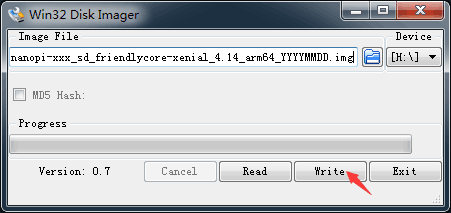
After it is installed you will see the following window:

- Insert this card into your board's BOOT slot and power on (with a 5V/2A power source). If the PWR LED is on and the STAT LED is blinking this indicates your board has successfully booted.
5.3.2.2 Flash to eMMC
5.3.2.2.1 Flash OS with eflasher Utility
- For more details about eflasher refer to the wiki link: EFlasher。
- Extract the eflasher Image and win32diskimager.rar files. Insert a TF card(at least 4G) into a Windows PC and run the win32diskimager utility as administrator. On the utility's main window select your TF card's drive, the wanted image file and click on "write" to start flashing the TF card.
- Insert this card into your board's BOOT slot and power on (with a 5V/2A power source). If the green LED is on and the blue LED is blinking this indicates your board has successfully booted.
- If your board doesn't support HDMI or no monitor is connected you can select an OS by running the following command:
$ su root
$ eflasherThe password for "root" is "fa".
We take "nanopi-neo-core2_eflasher_friendlycore-xenial_4.14_arm64_YYYYMMDD.img" as an example. After you run the "eflasher" command you will see the following messages:
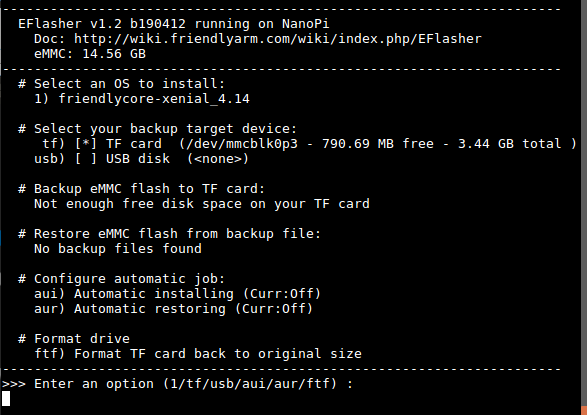
Type "1", select writing friendlycore system to eMMC you will see the following messages:
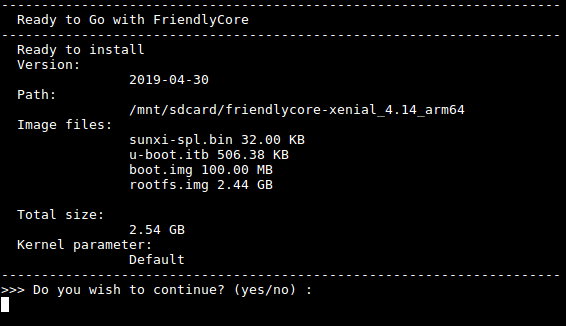
Type "yes" to start installation:

After it is done power off the system, take off the TF card, power on again your system will be booted from eMMC.
- If you want to flash other system to eMMC you can download the whole images-for-eflasher directory and extract the package under that directory to the FRIENDLYARM partition of an installation SD card.
6 Mini Shield for NanoPi NEO Core/Core2
Here is a setup where we connect a NanoPi NEO Core to a Mini Shield for NanoPi NEO Core/Core2. Here is an introduction to Mini Shield for NanoPi NEO Core/Core2 Mini Shield
:
Mini Shield for NanoPi NEO Core/Core2 和 Core2
7 Work with FriendlyCore
7.1 Introduction
FriendlyCore is a light Linux system without X-windows, based on ubuntu core, It uses the Qt-Embedded's GUI and is popular in industrial and enterprise applications.
Besides the regular Ubuntu Core's features FriendlyCore has the following additional features:
- it integrates Qt4.8;
- it integrates NetworkManager;
- it has bluez and Bluetooth related packages;
- it has alsa packages;
- it has npi-config;
- it has RPiGPIO, a Python GPIO module;
- it has some Python/C demo in /root/ directory;
- it enables 512M-swap partition;
7.2 System Login
- If your board is connected to an HDMI monitor you need to use a USB mouse and keyboard.
- If you want to do kernel development you need to use a serial communication board, ie a PSU-ONECOM board, which will
For example, NanoPi-M1: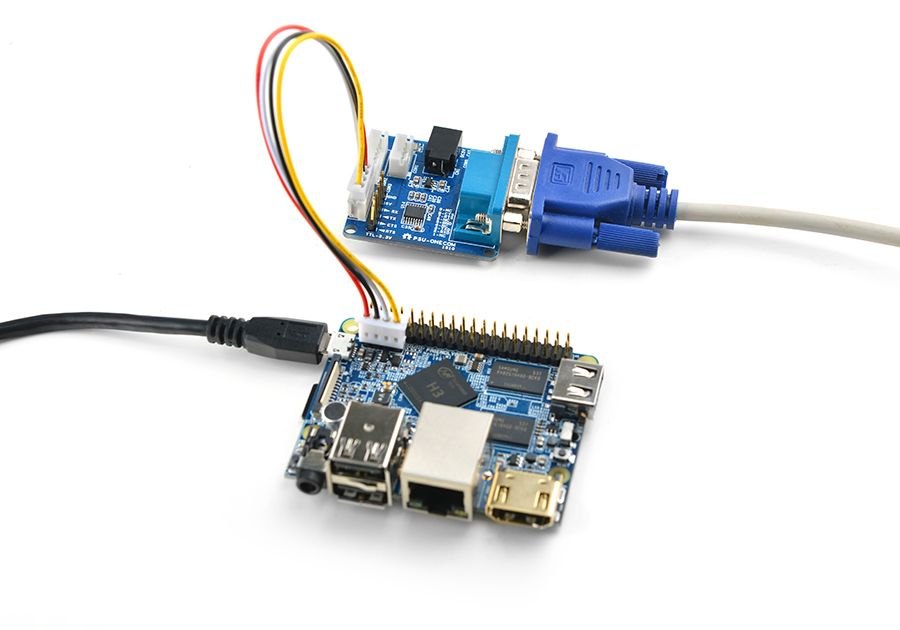
You can use a USB to Serial conversion board too.
Make sure you use a 5V/2A power to power your board from its MicroUSB port:
For example, NanoPi-NEO2: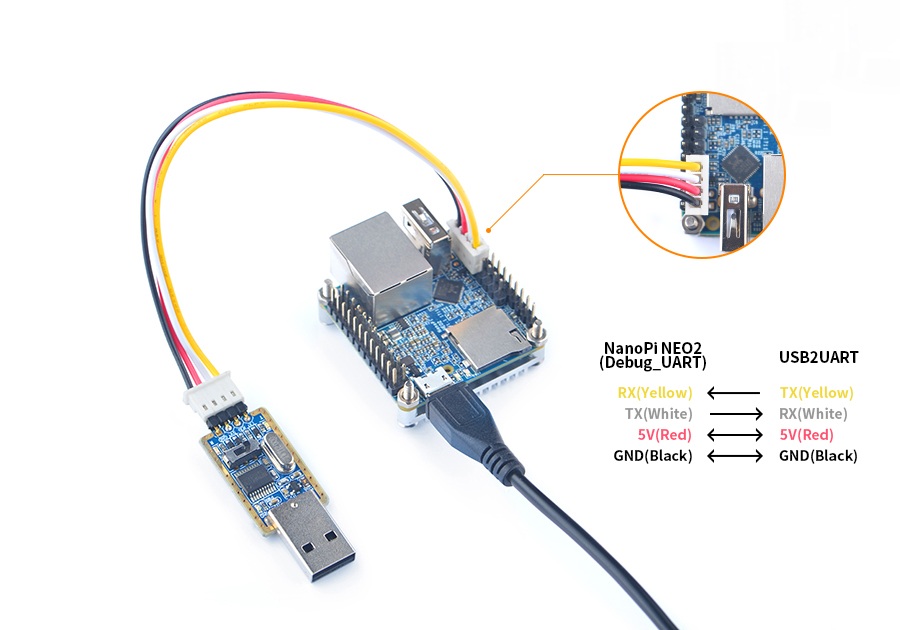
- FriendlyCore User Accounts:
Non-root User:
User Name: pi Password: pi
Root:
User Name: root Password: fa
The system is automatically logged in as "pi". You can do "sudo npi-config" to disable auto login.
- Update packages
$ sudo apt-get update
7.3 Configure System with npi-config
The npi-config is a commandline utility which can be used to initialize system configurations such as user password, system language, time zone, Hostname, SSH switch , Auto login and etc. Type the following command to run this utility.
$ sudo npi-config
Here is how npi-config's GUI looks like:

7.4 Develop Qt Application
Please refer to: How to Build and Install Qt Application for FriendlyELEC Boards
7.5 Setup Program to AutoRun
You can setup a program to autorun on system boot with npi-config:
sudo npi-configGo to Boot Options -> Autologin -> Qt/Embedded, select Enable and reboot.
7.6 Extend TF Card's Section
When FriendlyCore is loaded the TF card's section will be automatically extended.You can check the section's size by running the following command:
$ df -h
7.7 WiFi
For either an SD WiFi or a USB WiFi you can connect it to your board in the same way. The APXX series WiFi chips are SD WiFi chips. By default FriendlyElec's system supports most popular USB WiFi modules. Here is a list of the USB WiFi modules we tested:
Index Model 1 RTL8188CUS/8188EU 802.11n WLAN Adapter 2 RT2070 Wireless Adapter 3 RT2870/RT3070 Wireless Adapter 4 RTL8192CU Wireless Adapter 5 mi WiFi mt7601 6 5G USB WiFi RTL8821CU 7 5G USB WiFi RTL8812AU
You can use the NetworkManager utility to manage network. You can run "nmcli" in the commandline utility to start it. Here are the commands to start a WiFi connection:
- Change to root
$ su root
- Check device list
$ nmcli devNote: if the status of a device is "unmanaged" it means that device cannot be accessed by NetworkManager. To make it accessed you need to clear the settings under "/etc/network/interfaces" and reboot your system.
- Start WiFi
$ nmcli r wifi on- Scan Surrounding WiFi Sources
$ nmcli dev wifi- Connect to a WiFi Source
$ nmcli dev wifi connect "SSID" password "PASSWORD" ifname wlan0
The "SSID" and "PASSWORD" need to be replaced with your actual SSID and password.If you have multiple WiFi devices you need to specify the one you want to connect to a WiFi source with iface
If a connection succeeds it will be automatically setup on next system reboot.
For more details about NetworkManager refer to this link: Use NetworkManager to configure network settings
If your USB WiFi module doesn't work most likely your system doesn't have its driver. For a Debian system you can get a driver from Debian-WiFi and install it on your system. For a Ubuntu system you can install a driver by running the following commands:
$ apt-get install linux-firmware
In general all WiFi drivers are located at the "/lib/firmware" directory.
7.8 Ethernet Connection
If a board is connected to a network via Ethernet before it is powered on it will automatically obtain an IP with DHCP activated after it is powered up. If you want to set up a static IP refer to: Use NetworkManager to configure network settings。
7.9 WiringPi and Python Wrapper
- WiringNP: NanoPi NEO/NEO2/Air GPIO Programming with C
- RPi.GPIO : NanoPi NEO/NEO2/Air GPIO Programming with Python
7.10 Custom welcome message
The welcome message is printed from the script in this directory:
/etc/update-motd.d/
For example, to change the FriendlyELEC LOGO, you can change the file /etc/update-motd.d/10-header. For example, to change the LOGO to HELLO, you can change the following line:
TERM=linux toilet -f standard -F metal $BOARD_VENDOR
To:
TERM=linux toilet -f standard -F metal HELLO
7.11 Modify timezone
For exampe, change to Shanghai timezone:
sudo rm /etc/localtime sudo ln -ls /usr/share/zoneinfo/Asia/Shanghai /etc/localtime
7.12 Set Audio Device
If your system has multiple audio devices such as HDMI-Audio, 3.5mm audio jack and I2S-Codec you can set system's default audio device by running the following commands.
- After your board is booted run the following commands to install alsa packages:
$ apt-get update $ apt-get install libasound2 $ apt-get install alsa-base $ apt-get install alsa-utils
- After installation is done you can list all the audio devices by running the following command. Here is a similar list you may see after you run the command:
$ aplay -l card 0: HDMI card 1: 3.5mm codec card 2: I2S codec
"card 0" is HDMI-Audio, "card 1" is 3.5mm audio jack and "card 2" is I2S-Codec. You can set default audio device to HDMI-Audio by changing the "/etc/asound.conf" file as follows:
pcm.!default { type hw card 0 device 0 } ctl.!default { type hw card 0 }
If you change "card 0" to "card 1" the 3.5mm audio jack will be set to the default device.
Copy a .wav file to your board and test it by running the following command:
$ aplay /root/Music/test.wav
You will hear sounds from system's default audio device.
If you are using H3/H5/H2+ series board with mainline kernel, the easier way is using npi-config。
7.13 Connect to USB Camera(FA-CAM202)
The FA-CAM202 is a 200M USB camera. You can refer to <Connect DVP Camera (CAM500B) to Board> on how to connect a USB camera to a board.
You need to change the start.sh script and make sure it uses a correct /dev/videoX node. You can check your FA-CAM202's node by running the following commands:
$ apt-get install v4l-utils $ v4l2-ctl -d /dev/video1 -D Driver Info (not using libv4l2): Driver name : uvcvideo Card type : HC 3358+2100: HC 3358+2100 Bus info : usb-1c1b000.usb-1 ...
Information above indicates that /dev/video1 is the device node of the FA-CAM 202.
7.14 Check CPU's Working Temperature
You can get CPU's working temperature by running the following command:
$ cpu_freq CPU0 online=1 temp=26581 governor=ondemand cur_freq=480000 CPU1 online=1 temp=26581 governor=ondemand cur_freq=480000 CPU2 online=1 temp=26581 governor=ondemand cur_freq=480000 CPU3 online=1 temp=26581 governor=ondemand cur_freq=480000
This message means there are currently four CPUs working. All of their working temperature is 26.5 degree in Celsius and each one's clock is 480MHz.
7.15 Test Watchdog
You can test watchdog by running the following commands:
$ cd /root/demo/watchdog/ $ gcc watchdog_demo.c -o watchdog_demo $ ./watchdog_demo /dev/watchdog0 10 Set timeout: 10 seconds Get timeout: 10 seconds System will reboot in 10 second
System will reboot in 10 seconds.
7.16 Test Infrared Receiver
Note: Please Check your board if IR receiver exist.
By default the infrared function is disabled you can enable it by using the npi-config utility:
$ npi-config
6 Advanced Options Configure advanced settings
A8 IR Enable/Disable IR
ir Enable/Disable ir[enabled]Reboot your system and test its infrared function by running the following commands:
$ apt-get install ir-keytable $ echo "+rc-5 +nec +rc-6 +jvc +sony +rc-5-sz +sanyo +sharp +mce_kbd +xmp" > /sys/class/rc/rc0/protocols # Enable infrared $ ir-keytable -t Testing events. Please, press CTRL-C to abort.
"ir-keytable -t" is used to check whether the receiver receives infrared signals. You can use a remote control to send infrared signals to the receiver. If it works you will see similar messages as follows:
1522404275.767215: event type EV_MSC(0x04): scancode = 0xe0e43 1522404275.767215: event type EV_SYN(0x00). 1522404278.911267: event type EV_MSC(0x04): scancode = 0xe0e42 1522404278.911267: event type EV_SYN(0x00).
7.17 Read CHIP ID
As for Allwinner H2+/H3/H5/ SoCs each of these CPUs has an internal 16-btye CHIP ID which can be read by running the following commands in the Linux-4.14 kernel:
$ apt-get install bsdmainutils $ hexdump /sys/bus/nvmem/devices/sunxi-sid0/nvmem 0000000 8082 0447 0064 04c3 3650 ce0a 1e28 2202 0000010 0002 0000 0000 0000 0000 0000 0000 0000 0000020 0000 0000 0000 0000 0000 0000 0000 0000 0000030 0000 0008 0508 0000 0000 0000 0000 0000 0000040 0000 0000 0000 0000 0000 0000 0000 0000
"8082 0447 0064 04c3 3650 ce0a 1e28 2202" is the 16-byte CHIP ID.
7.18 Access GPIO Pins/Wirings with WiringNP
The wiringPi library was initially developed by Gordon Henderson in C. It contains libraries to access GPIO, I2C, SPI, UART, PWM and etc. The wiringPi library contains various libraries, header files and a commandline utility:gpio. The gpio utility can be used to read and write GPIO pins.
FriendlyElec integrated this utility in FriendlyCore system allowing users to easily access GPIO pins. For more details refer to WiringNP WiringNP
7.19 Run Qt Demo
Run the following command
$ sudo /opt/QtE-Demo/run.sh
Here is what you expect to observe. This is an open source Qt Demo:

7.20 How to install and use docker (for arm64 system)
7.20.1 How to Install Docker
Run the following commands:
sudo apt-get update sudo apt-get install docker.io
7.20.2 Test Docker installation
Test that your installation works by running the simple docker image:
git clone https://github.com/friendlyarm/debian-jessie-arm-docker cd debian-jessie-arm-docker ./rebuild-image.sh ./run.sh
7.21 Play & Record Audio
Core2's audio interface is populated to a 2.54mm pitch pin-header. Here is the pin description:
Pin# Name Description 1 MICIN1P Microphone Positive Input 2 MICIN1N Microphone Negative Input 3 LINEOUTR LINE-OUT Right Channel Output 4 LINEOUTL LINE-OUT Left Channel Output
Here is a hardware setup for connecting an audio device to a NanoPi NEO Core2:
耳麦标注
Make sure an audio device is connected to your NEO Core2 and you can play and record audio by running the following commands.
List audio device:
$ aplay -l **** List of PLAYBACK Hardware Devices **** card 0: Codec [H3 Audio Codec], device 0: CDC PCM Codec-0 [] Subdevices: 1/1 Subdevice #0: subdevice #0
Both Allwinner H5 and H3 have a codec device which is recognized in the kernel as [H3 Audio Codec].
Play audio:
$ aplay /root/Music/test.wav -D plughw:0
Record audio:
$ arecord -f cd -d 5 test.wav
8 Make Your Own FriendlyCore
8.1 Use Linux-4.14 BSP
The NanoPi NEO Core2 only works with 64-bit Linux-4.14 and 64-bit UbuntuCore 16.04. For more details about how to use mainline u-boot and Linux-4.14 refer to :Building U-boot and Linux for H5/H3/H2+
9 Connect External Modules to NEO Core2
9.1 Connect Python Programmable NanoHat OLED to NEO Core2
The NanoHat OLED module is a small and cute monochrome OLED module with low power consumption. It has three user buttons. We provide its driver's source code and a user friendly shell interface on which you can check system information and status.A customized aluminum case is made for it. You cannot miss this lovely utility! Here is a hardware setup:NanoHat OLED
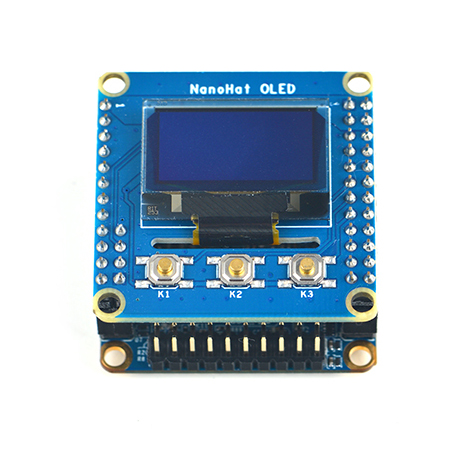
9.2 Connect Python Programmable NanoHat Motor to NEO Core2
The NanoHat Motor module can drive four 5V PWM steering motors and four 12V DC motors or four 5V PWM steering motors and two 12V four-wire step motors.Here is a hardware setup: NanoHat Motor
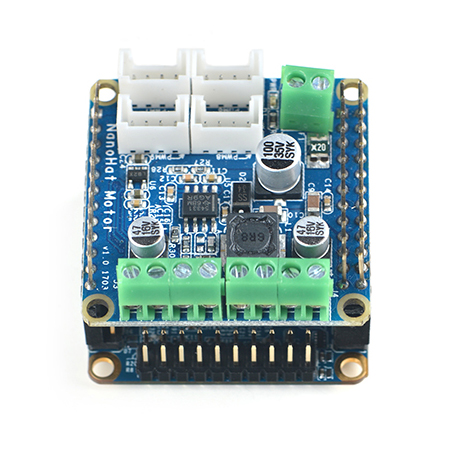
9.3 Connect NanoHat PCM5102A to NEO Core2
The NanoHat PCM5102A module uses TI's DAC audio chip PCM5102A, a convenient and easy-to-use audio module for hobbyists. Here is a hardware setup:NanoHat PCM5102A
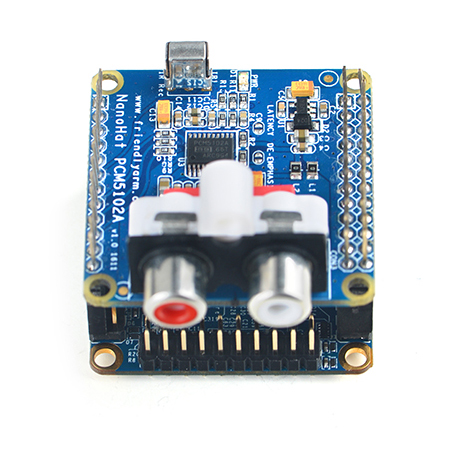
9.4 Connect Arduino Compatible UNO Dock to NEO Core2
The UNO Dock module is an Arduino board compatible with Arduino UNO and works with Arduino programs.You can use Arduino IDE to run all Arduino programs on the Dock.It also exposes the NanoPi NEO Core2's pins.It converts 12V power input to 5V/2A output.You can search for various code samples from Ubuntu's ecosystem and run on the Dock. These features make it a powerful platform for IOT projects and cloud related applications. Here is a hardware setup:UNO Dock for NanoPi NEO v1.0
Matrix-UNO_Dock_NEO_Core2
9.5 Connect NanoHat Proto to NEO Core2
The NanoHat Proto is an expansion board which exposes NEO Core2's various pins.It has an onboard EEPROM for data storage.Here is a hardware setup:NanoHat Proto
Matrix - NanoHat Proto_nanopi_NEO_Core2
9.6 Connect Matrix - 2'8 SPI Key TFT to NanoPi NEO Core2
The Matrix-2'8_SPI_Key_TFT module is a 2.8" TFT LCD with resistive touch. It uses the ST7789S IC and XPT2046 resistive touch IC. It has SPI interface and three configurable user keys.Here is its wiki page Matrix - 2'8 SPI Key TFT
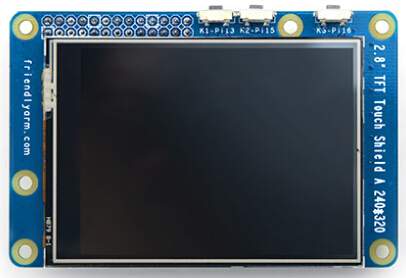
10 3D Printing Files for Housing
11 Resources
11.1 Datasheet & Schematic
- Schematic
- Dimensional diagram
- H5 datasheet Allwinner_H5_Datasheet_V1.0.pdf
- article
12 Update Log
12.1 Dec-1-2017
- Released English version
